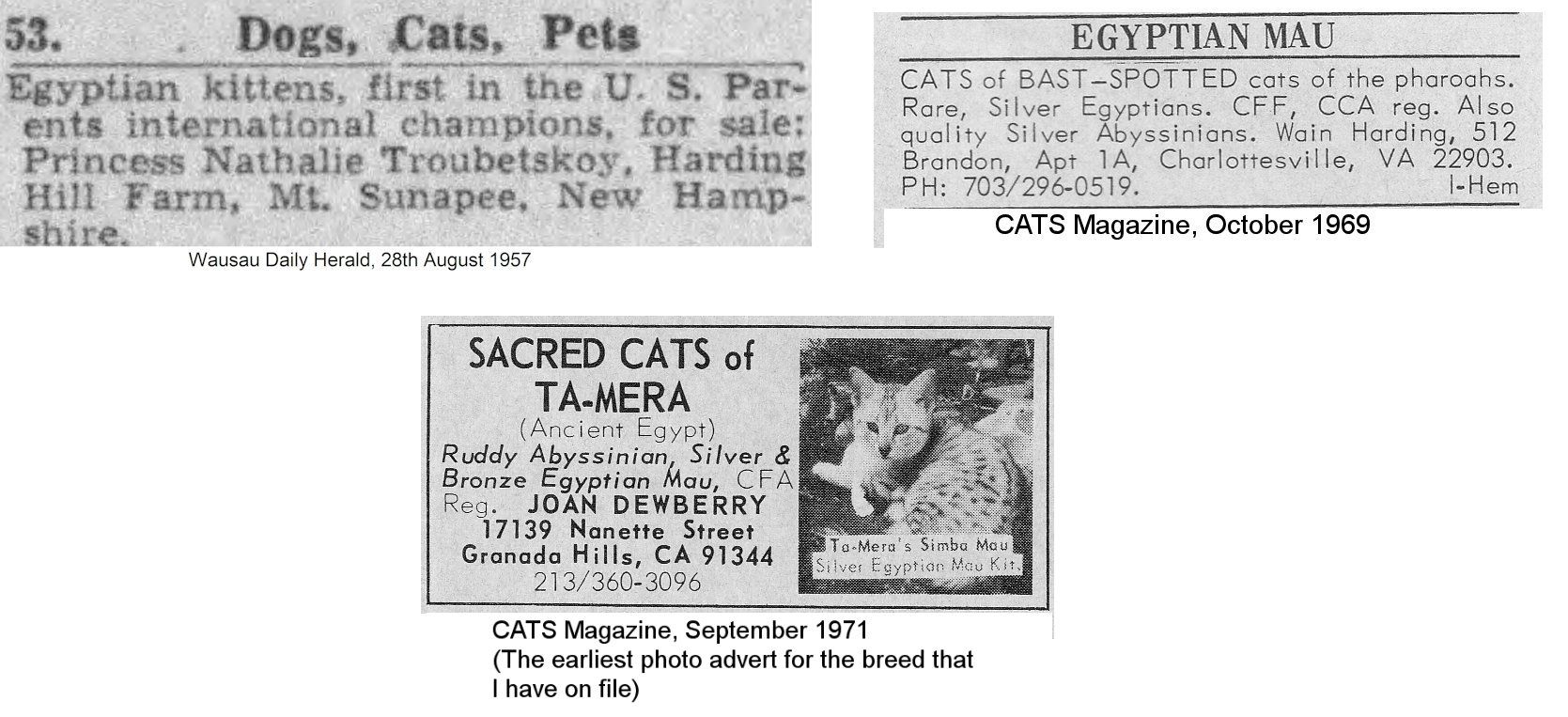
EGYPTIAN MAU HISTORY
Although it is regarded as an ancient breed, the modern Egyptian Mau was developed in Europe from spotted cats imported from the Middle East. Cats resembling Egyptian Maus are depicted in Egyptian artwork over 3000 years old. Those ancient Mau-like cats were trained to hunt and retrieve birds. Although it is often stated that the Egyptians worshipped cats, mourned their death and that harming a cat was an offence punishable by death, the truth is that temples bred cats en masse to be sacrificed and mummified as devotional objects.
Several cat mummies from around 1000 BC have been unwrapped, and some revealed a spotted tabby pattern, so we know that spotted domestic cats were common in ancient Egypt. Other unwrapped cat mummies appear to have had fawn-coloured ticked fur. It is hard to reach definite conclusions as often only the skin remains, not the fur itself. The Romans were probably responsible for taking spotted cats from Egypt back to Italy in the early centuries AD, a quite likely to other parts of Europe during the Roman occupation. Spotted cats are depicted in a number of Roman mosaics, including one found at Pompeii.
"Mau" is a Middle Egyptian onomatopoeic word that means "cat". The breed name means "Egyptian Cat." After World War II, the trade in fancy cats resumed and the native spotted domestic cats in Egypt became increasingly mongrelised with stray pets, losing their distinctive identity. This situation that continues in many countries today due to the popularity of Siamese, Persians and other fancy breeds. In Egypt they were known simply as "maus." It is a myth that the Egyptian Mau is the only naturally occurring spotted cat, as some breeders claim, and it shares its claim to be a naturally spotted breed with the Bahraini Dilmun cat.
RENEY'S EGYPTIAN SHORTHAIR CAT
Egyptian-type cats were bred in France, Italy and Switzerland in the first half of the 20th century. Marcel Reney's book "Nos Amis Les Chats" (Our Friends the Cats) published in France in 1947 described an Egyptian short-hair. These sound much like modern Oriental cats and appeared in solid colours and spotted varieties, but not striped tabbies. I have translated this book and the description of the Egyptian cat is:
Slender European Cats (Egyptians)
Standard and scale of points
Body. - The opposite of short-haired striped tabbies. Rather slender, standing tall on slender legs; slightly curved slender neck. Long thin tail, completely smooth. We must first take into account the form when judging the slender European cat.
Head. - Carried high. Top of head is narrow, slightly curved. Forehead descends to the nose without a stop. Muzzle straight or slightly curved, long and pointed. Ears large but not too wide.
Eyes. - Slightly oblique. The colour varies according to that of the coat: green for blues; yellow for blacks, tortoiseshells, reds, etc., blue or yellow for whites.
Hair. - Velvety, a little thick, but not rough.
Colour. - No tabby pattern is tolerated. Only plain, smoked, patched and tortoiseshell, provided there is no pattern, are allowed. Tortoiseshells and tortoiseshell-and-whites, Russian Blues (the slender form of the blue short hair with eyes as green as possible) and spotted cats (whose coat is strewn with numerous small round or oblong spots, sometimes in the form of rosettes, clearly defined, but without forming lines) are arranged in this variety.
The C.I.F. offers the same scale of points for single colors and spotted cats. I cannot agree with this solution as it does not take into account the importance of markings in the spotted variety. So, here in my opinion are two scales of points on which the judging of this variety should be based.
EARLY DEVELOPMENT
The progenitors of the Egyptian Mau arrived in Italy in 1953. According to some accounts, the modern Egyptian Mau began when exiled Russian Princess Nathalie Troubetskoy (or Troubetskaya / Trubetskoy), who was living in Italy, met a cat belonging to the Egyptian Ambassador to Italy. Intrigued by its looks, she persuaded the Ambassador to import several cats from Egypt for her. According to others, she was given a silver spotted Mau kitten by a boy who had received it from a diplomat working in the Middle East and she persuaded the Syrian Embassy to obtain more cats from Egypt. Yet another account says that Troubetskoy was so impressed by the spotted markings of street cats in Cairo, that she imported a spotted female to Italy to mate with a local tom. Either way, her Egyptian spotted cats became the basis of a breeding programme.
In Italy, Troubetskoy started with Gregorio, a black male, and Lulu (or Ludol), a silver spotted female. She later used diplomatic contacts to import additional cats from the Middle East. One of these was a smoke male named Geppa. Her first litters of Maus were born in Italy in 1953 and 1954 and the kittens were widely exhibited in Europe.
In 1956, Troubetskoy emigrated to the USA, taking three Egyptian Maus with her: two silver females, Fatima Baba, (Geppa x Lulu) and Liza, and Baba's bronze son, Fatima Jojo (Giorgio) (Gregorio x Fatima Baba). These formed the foundation for her cattery named Fatima. The third cat, Liza (Baba and Jojo) seems not have bred. In 1958, Troubetskoy imported Claire Fatima, a silver spotted female, from Rome. She may also have imported a further male.

Such low numbers would have made inbreeding inevitable so Troubetskoy must have outcrossed her purebred Maus to other cats to keep the gene pool healthy even if these outcrosses have been hidden on early pedigrees. Early pedigrees show only silver, bronze and (black) smoke coloured cats. Where there are smokes there are also solid black cats, even if these were not recorded or bred from. Outcrossing would also have introduced the classic tabby pattern and the blue colours that sometimes occur in the Modern Egyptian Mau. Being the first truly spotted fancy cat, the breed quickly became popular.
The New York Daily News, 17th December 1956, described the arrival of the first 3 cats thus: "NEWCOMERS: Three cats, a pair and one offspring, have just come to the U.S. from Rome, brought here by Princess Nathalie Troubetskoy . . . The princess, a well-known magazine writer and cat fancier, brought her rare Egyptian kitties, first of their breed ever to reach the country, to the Orange, N.J. home of Richard H. Gebhardt, vice president of the Garden State Cat Club. Those who have seen the arrivals declare they are impressive creatures, and they may well be descendants of the Egyptian kitties that were held in reverence and worshiped in ancient times."
In October 1957, an Egyptian Mau appeared at the Boston Cat Show "An exhibit by Russian Princess Nathalie Troubetskoy of Sunapee. N.H., attracted many." (Newton Siamese Wins Champion Cat Show Honor, The Boston Globe, 1st November 1957) and "A special attraction will be Princess Nathalie Troubetskoy, nurse, lecturer, writer, and cat fancier, who will exhibit her rare Egyptian cats. Her cats have won honors and have been exhibited in many European shows." (Boston Cat Club's 52d Annual Show Thursday and Friday, The Boston Sunday Globe, 27th October 1957, pg 82-A.)
This photo of a later import appeared in the New York Daily News, 13th July 1958. Page 34 (Sunday Edition): "Egyptian Cat. This alert-looking feline is a very rare cat indeed. She is Claire Fatima, an Egyptian kitten, flown here from Rome, Italy and is owned by former Russian Princess Natalie Troubetskov Unfortunately the cat was so nervous that it was impossible to get her to stand still. Consequently, the cat's extra-long hind legs, which give her rear an upward slope, can't be seen."
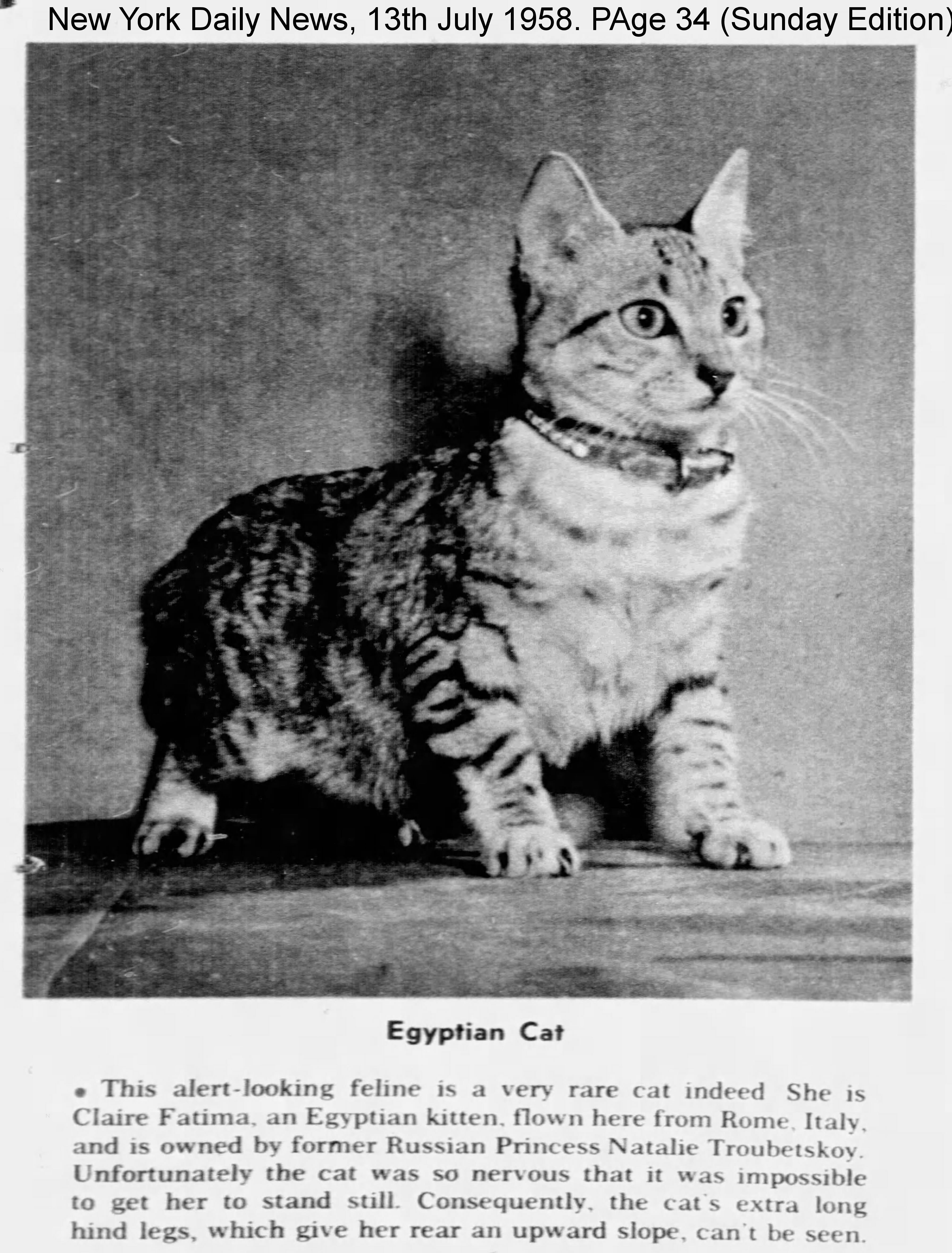
In 1968, this description appeared in the Ottawa Citizen. Newcomer. One of the most exciting entries will be an Egyptian Mau. In years gone by these cats were carried all over Europe by traders and inter-breeding with the native wild cats produced the domestic cats. Now, centuries later, these animals are beginning to appear in the breed known as the Delta Wilds and a few have been brought to this continent although there are actually, less than 100 on the North American continent. Very affectionate, this breed is usually silver in color with a frosted look, although there are a few ruddy-colored ones. They are heavily barred with spotted sides, banded tails and green eyes which can change color to amber." - (You...and I By Molly Deprose Colorful Cats, Ottawa Citizen, 28th October 1968)
[Note: I can find no other reference to a "Delta Wilds" breed and assume this to be an error.]
THE INDIAN LINES
In 1980 Jean Mill (Millwood prefix), most famous for developing the Bengal breed, imported a bronze rosetted stray cat and a bronze female - Toby and Tashi - from New Delhi Zoo, India for her own breeding programme. As well as their contribution to the Bengal breed, those two cats created the "Indian Mau" breed line that was incorporated into the Egyptian Mau.
During a trip to India, Mill noticed a domestic cat "running around the rhinoceros compound" in a zoo. "He was an orange cat with little spots all over him. He was so unusual, I asked [the zookeepers] to catch him for me." The curator of the New Delhi Zoo also gave Mill the cat's sister Mill called these Indian cats "Millwood Toby of Delhi" and "Millwood Tasha of New Delhi". They introduced features previously not seen in the Mau: rufousing and glitter. Some descendants of Toby and Tasha were recorded as both Egyptian Mau and Bengal. They changed the colour of bronze Maus from the original sandy brown to the richer rufous coppery brown preferred today. On the other hand, their influence changed the Mau's head type, losing its characteristic, heavy brow and worried expression. One of the original distinguishing features- the primordial flap (and apron of loose skin from the belly to the hind legs) which allows a longer running stride - is also in danger of being lost from the breed.
The acceptance of the Indian lines by the very conservative CFA hinged on the argument that Egyptian cats could have reached India via traditional trade routes so that Mill's spotted Indian cats were, therefore, descendants of Egyptian cats and not really outcrosses. This maintained the status of the Egyptian Mau as a natural breed with no allowable outcrosses. It is important to note that the Millwood cats did not introduce bronze into the breed, Troubetskoy's foundation male Fatima Jojo was a bronze.
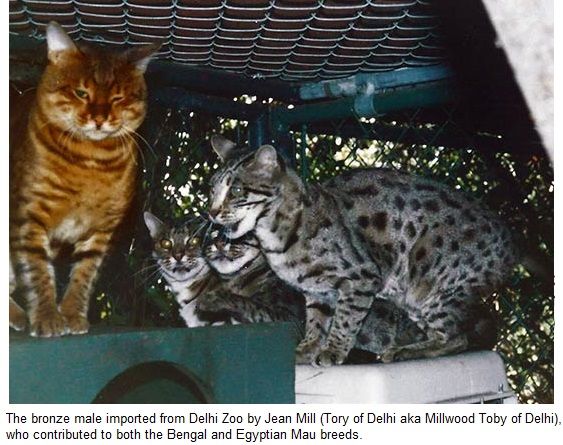
THE NEW EGYPTIAN LINES
The importation of the Indian cats was a controversial move, but it paved the way for further imports in the 1980s and 1990s of around 20 foundations cats from Egypt that met the Egyptian Mau breed standard to improve the breed's genetic diversity. The new "Egyptian Lines" tended to be larger and more vigorous than the now inbred original breeding lines.
In the 1980s, Cathie Rowan (Rocat prefix) imported 13 Maus from Egypt into the USA, but there was limited interest in these cats from other breeders, and their descendants are not widely represented.
In the early 1990s J. Len Davidson (Grandtrill prefix) obtained 4 cats from Egypt, including bronze females Giza and Wafaya, and developed the Grandtrill line of Egyptian Maus which did attract interest from American breeders.
In 1999 A bronze male named Sahoure of Fondcombe was imported into France by Didier and Marie-Christine Hallepee In 2001, they imported a second bronze male, Maslama of Fondcombe, who produced bronze, silver and smoke offspring.
The Egyptian Mau Rescue Organization is an adoption agency for Egyptian and Arabian street cats of unknown pedigree. Thesy cannot be registered as foundation Egyptian Maus unless they meet an exacting standard. In the CFA, the imported cats are termed "Native Maus". When bred to pedigree Egyptian Maus, the second and third generation are "Domestic Maus". The fourth generation cats may be registered if they meet the Egyptian Mau breed standard. Because it may not be outcrossed to any other breeds these imports are essential to maintain a healthy gene pool.
As a result of the limited gene pool and careful selective breeding, Egyptian Maus occur in five colors, only three of which are recognised for exhibition. From most to least common these colors are: silver spotted, bronze spotted, smoke (with ghost spotting), solid black and blue/pewter (spotted, smoke and solid). Classic tabby and solid blue variants sometimes occur due to recessive genes.
BLUE-EYED EGYPTIAN MAUS
Wain Harding, Secretary Egyptian Mau Breeders & Fanciers Association (May 1971 Cats Magazine): "I was very interested in your recent article 'The Cat That Couldn't Be Bred' by Mrs. Sayer. The Egyptian Mau breeders have recently had four blue-eyed kittens from different parents. These kittens are beautiful well spotted, silver Mau with deep blue eyes. All of these kittens share a common grand or great-grand parent (Kattiwyckes Gulliver x Kattiwyckes Trinket owned by Mrs. Ann Cahill). The first of these blue-eyed beauties appeared in one of my own litters (Kattiwyckes Umm Usada bred to her son Bast's Zosser). I kept waiting for this kittens eyes to change as it is often four months before a Mau kitten's eyes change from blue to the desired gold. I exhibited Chui Chali at the Fall Baltimore CFA show when he was six months old. I still insisted that his eyes would change to the admiring public. The kitten's eyes never changed and he grew up and sired a litter now nine days old. We are anxiously waiting for the kittens to mature.
The second kitten appeared in a litter of Ann Cahill's breeding. This beautiful young female, Kattiwyckes Dynamite, will soon be bred to Bast's Chui in the hopes of producing an all blue-eyed litter. The third blue-eyed baby appeared in a litter of kittens bred by Barbara Abruzzo of New Jersey. The fourth kitten appeared in a litter bred by Joan Dewberry of Ta-Mera Cattery in California. We are very proud of our blue-eyed stock and have great expectations for these kittens. The most plausible explanation for the blue-eyed mutation has to do with the amount of inbreeding that has been necessary to keep the Egyptian Mau the pure, natural breed it was upon importation. Bast Chui Chali is now at stud to Egyptian Mau queens of pure ancestry as well as to approved Foreign Short- hair breeders interested in breeding a foreign type cat with blue eyes. We are helping a breeder develop blue-eyed blacks at the present time. The Egyptian Mau Breeders and Fanciers Association are happy to announce blue eyed Mau kittens and gene-carriers in the near future."
RECOGNITION
The Egyptian Mau was recognised as early as 1968 by some organisations and by TICA in 1979. They first arrived in the UK in late 1998 and achieved recognition in 2004. They are rare in the UK and continental Europe. They are also recognized in Australasia.
IN BRITAIN
The initial Egyptian Mau in Britain was not the same as the American-bred cat. Because of the stringent quarantine restrictions in Britain, British breeders recreated the Egyptian Mau "by scientific means" using Abyssinians and Siamese and the English standard differed from the American one in that it required a clearly defined scarab beetle mark between the ears, and breeding stock was selected for the clarity of this mark. Later on, this breed was to be renamed the Oriental Spotted to avoid confusion with the American breed it had tried to recreate scientifically. Similar happened in one Australian state, and for the same reason, where Spotted Orientals were dubbed "Egyptian Maus" though they bore no resemblance to the "real" Egyptian Mau.
Melissa Bateson was introduced the first true Egyptian Mau to the UK in 1998 starting with 3 silver females: EMau's Isis of New Kingdom, EMau's Nephthys of New Kingdom and J's Iris Qetesh of New Kingdom, and a silver male Sharbees Mihos of New Kingdom. These were later followed by silver and bronze imports. Egyptian Maus in the UK include descendants from the original lines, Indian lines and "new Egyptian lines." It does not allow outcrossing to other breeds, but considers the gene pool to be sufficiently diverse for breed health.
DNA ANALYSIS
DNA analysis found that Egyptian Maus may resemble ancient Egyptian cats, but they have strong European influences. DNA studies show they are more closely related to random-bred cats of Turkey and Tunisia than to random-bred Egyptian cats. Mitochondrial DNA analysis in 2005 grouped the Egyptian Mau with Siamese, Russian Blue, Korat and Abyssinian cats. The later STR and SNP studies clustered it with American-bred Turkish Angoras and Turkish Vans. Outcrossing to Russian Blues or Korats would explain the blue Egyptian Mau variants that sometimes appear in Egyptian Mau. Abyssinian outcrosses may have had the classic tabby or mackerel tabby genes masked by the ticked pattern. The lack of colourpoint Mau variants mean Siamese were not used as outcrosses.
PRINCESS NATHALIE TROUBETSKOY.
Princess Nathalie Troubetskoy was born in 1897 in Lublin, Poland and was a member of an influential Russian family. The following cuttings give some information about her life.
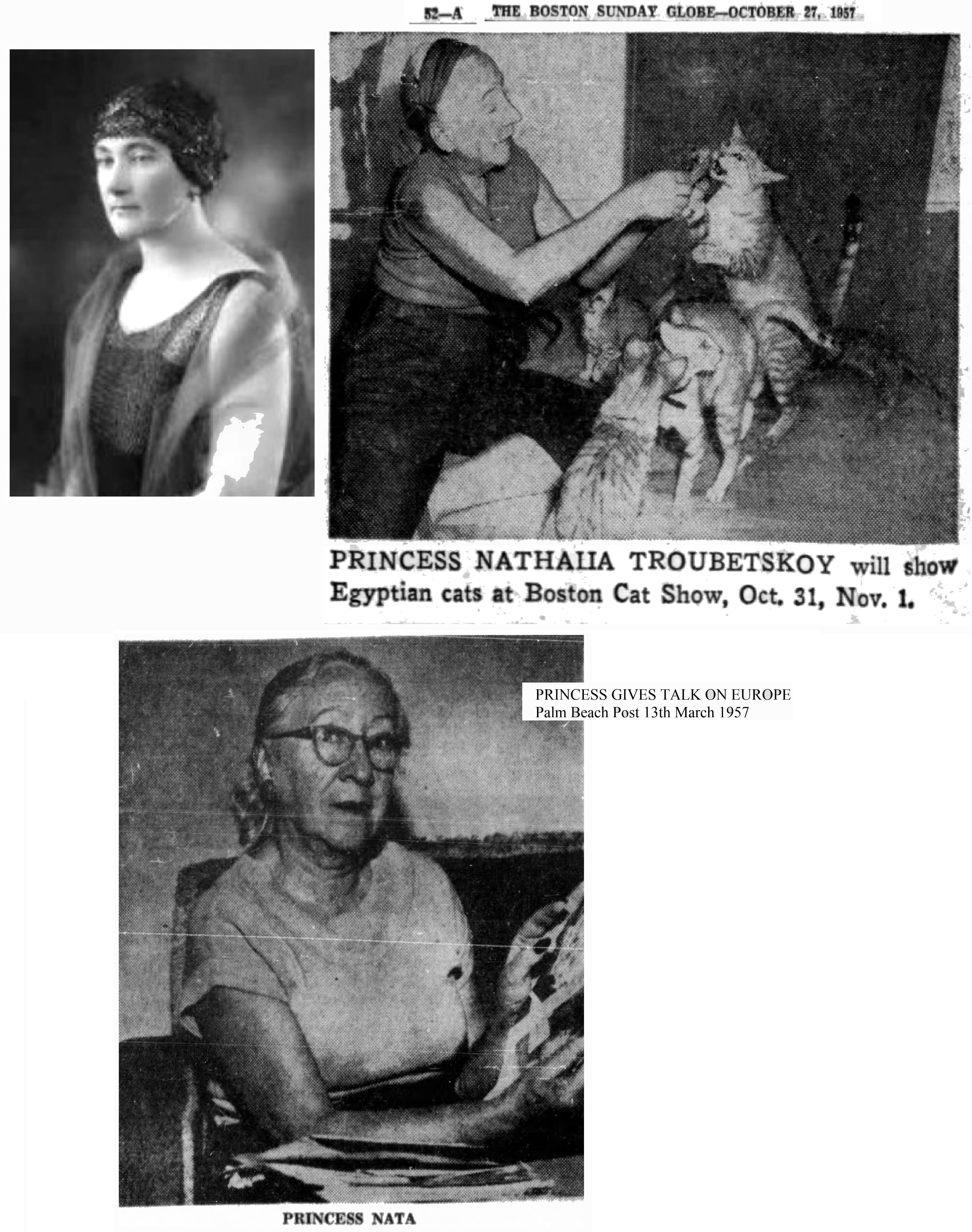
RAISES EGYPTIAN CATS. VERSATILE RUSSIAN PRINCESS WAS NURSE, LECTURER, WRITER. (Palm Beach Post 24th February 1957)
LAKE WORTH - When an individual experiences the ravages of two world wars, a revolution - and then lives among people who are victims of a turned over world a greater wisdom often develops that personality into one of great stature. That quality is reflected in the Princess Nathalie Troubetskoy, houseguest of Mrs. William Bennett, 1620 N. N St. The Russian visitor who has lived a life of exceptional variety embracing all those experiences, has also devoted many years of service to others. She is visiting the United States for the first time. Circumstances that brought her to Florida are typical of incidents that have eolored her life.
Princess Troubetskoy was born at Lublin, Poland. Her father was governor of that province but the family estate was in the Ukraine. As a youngster she learned the English language from governesses and Irish nurses and by the time she was 14, was enrolled in medical school at Petrograd (Leningrad) Medical School. The Kerensky Red revolution quickly terminated her education as the ruling nobility were forced to flee for their lives. She said her mother and aunts disappeared during the Ukraine fighting and she has never learned their fate. Today she has no immediate relative!
The woman who possesses such stature despite her petite size, served as a nurse on Russian battle fronts throughout World War I. Later she was transferred to England with the British Imperial Nursing Service and eventually saw more service with the Salonika Expeditionary forces. When peace finally came and demobilization was completed, Princess Troubetskoy took up residence in England where she lived for 20 years. A new life was crowded with welfare activities lecturing and broadcasting for the British Broadcasting Company. She quickly earned a deserved reputation for the tremendous efforts she exerted toward rehabilitation of youngsters from destitute families, as well as orphans.
Prior to World War II, the Princess went to Italy and once more, served as a nurse. . .This time in a top capacity with the American forces after the United States entered the war in 1941. After the cessation of hostilities, she became secretary-librarian of the American Church of Santa Susanna in 1948 and contributed articles to American and British publications. Many of her children's stories have also appeared in American editions of 'Best Short Stories of the Year.'
While living at Rome, the charming woman who has an electric vitality and warmth added another interest to her busy existence. She was given a small kitten by a friend who told her it was taken from a small boy who constantly abused the animal. The cat had unusual features and coloring and Princess Troubetskoy wanted to investigate its background. With the assistance of friends and numerous references, she learned the kitten was definitely a descendent of a rare Egyptian breed. Intrigued with the animal that charmed her with its acute intelligence, the Princess later got several other cats of the same breed. She showed them in Euronean pet shows and one ultimately was awarded coveted top honors in its class for all independent Europe.
Through the years, the Princess cherished a dream of coming to America and when the possibility of coming seemed to be more than just that, she started making arrangements for transporting the cat. Red tape was tiring and almost insurmountable. However special permission was finally granted from government agencies here and from the airline on which she arrived last December.
Advance correspondence with Richard Gebhardt of Orange, N.Y., president of the National Association of Cats, assured the woman of a sincere welcome. She reported. 'Mr. Gebhardt was so very kind. He even extended me an invitation to visit his home and graciously told me I could leave the cats there, before I left for Florida. He was a most accommodating man, particularly since all arrangements were made before we had even met personally.'
Princess Troubetskoy arrived in New York from Rome and went directly to Orange. Then she left for Spencer, Wisc., to see the friends 'most directly responsible' for her visit to this country. They were Mr. and Mrs. Raymond Tack (he is a brother of Mrs. Bennett, her hostess). The Tacks were ardent supporters of the CARE program that has sent much food and clothing abroad to children and adults. Months ago they saw a picture of Princess Troubetskoy in a national pictorial magazine regarding her welfare work in Rome. Impressed, they decided to write the Russian woman. Hundreds of letters were eventually exchanged and when the Tacks discovered the desire of the Princess to come here, they formulated plans.
Difficulties beset the couple since the Princess was listed as of Polish descent and the Polish immigrant quota was filled. In 1953 changes were made in the United States quota law that recognized her Russian status and accompanying openings for her entry to this country made possible easier entry. After many arduous details were overcome, the road was cleared and Princess Troubetskoy came to America.
What of the future? Her plans are not nebulous. The Princess has excellent command of the English language and possesses a remarkably sharp, analytical mind. Her writings have received acclaim and her lectures have had unchallenged success. A new life in a new country offers an exciting future. Princess Troubetskoy hopes to introduce the Egyptian cats to cat fanciers here. She said they are 'wonderful pets.' And she will be of untold help in informing others of an international situation that sometimes defies a solution. When she alighted at the airport in New York, the United States welcomed a woman of nobility - in fact and theory!
PRINCESS GIVES TALK ON EUROPE (Palm Beach Post 13th March 1957)
LAKE WORTH - A talk on her experiences abroad and in the United States by Princess Nathalie Troubetskoy highlighted the meeting of the Entre Nous Club Monday in the home of Mrs. J. C. Emgram, 1832 N. Second Ave. The Russian noblewoman who has been in this country for three months discussed her childhood in Poland where she was the daughter of a governor in a Polish province, and events caused by two World Wars that led to her lengthy residence in England and eventually Italy, from which point she departed for this country. Princess Troubetskoy explained her activities in welfare work, lecturing and broadcasting abroad and the terrors of the wars. She served with the 2675 U.S. Regiment as chief nurse and later special service and welfare advisor during World War II in Italy, and concluded 'my one ambition since a child, has been to come here someday to make my home in America.'
THE FALSE EGYPTION MAU
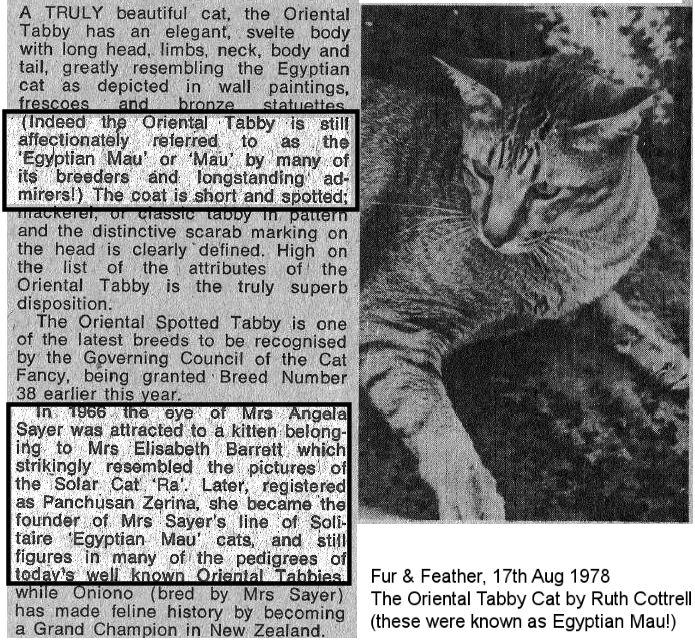
DNA STUDIES:
J. D. Kurushima, M. J. Lipinski, B. Gandolfi, L. Froenicke, J. C. Grahn, R. A. Grahn and L. A. Lyons (2012) "Variation of cats under domestication: genetic assignment of domestic cats to breeds and worldwide random-bred populations" Animal Genetics, 2012 (cited as Kurushima et al, 2012)
Lipinski M.J., Amigues Y., Blasi M. et al. (2007) An international parentage and identification panel for the domestic cat (Felis catus). Animal Genetics 38, 371-7.
Lipinski M.J., Froenicke L., Baysac K.C. et al. (2008) The ascent of cat breeds: genetic evaluations of breeds and worldwide randombred populations. Genomics 91, 12-21.
Leslie A. Lyons "Genetic Relationships of Cat Breeds" at Tufts' Canine and Feline Breeding and Genetics Conference 30/09/2005 - 01/10/2005, 2005, Sturbridge, MA, USA (cited as Lyons, 2005)
Leslie A. Lyons/ UC Davis "Genetic Identification of Domestic Cat Breeds and Populations" Patent application 61/487,987. Filed on May 19, 2011